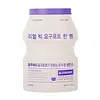What's inside
What's inside
 Key Ingredients
Key Ingredients

 Benefits
Benefits

 Concerns
Concerns

 Ingredients Side-by-side
Ingredients Side-by-side

Water
Skin ConditioningPropanediol
SolventYogurt Extract
Skin ConditioningLactobacillus Ferment Lysate Filtrate
Skin ConditioningVaccinium Angustifolium Fruit Extract
Skin ProtectingSodium Hyaluronate
HumectantHydroxyacetophenone
AntioxidantGlycerin
HumectantPEG-60 Hydrogenated Castor Oil
EmulsifyingEthylhexyl Palmitate
EmollientAcrylates/C10-30 Alkyl Acrylate Crosspolymer
Emulsion StabilisingBetaine
HumectantTromethamine
BufferingHydroxyethyl Acrylate/Sodium Acryloyldimethyl Taurate Copolymer
Emulsion StabilisingCetyl Ethylhexanoate
EmollientPolyglyceryl-10 Oleate
Skin ConditioningHydrogenated Lecithin
EmulsifyingDisodium EDTA
Ethylhexylglycerin
Skin Conditioning1,2-Hexanediol
Skin ConditioningParfum
MaskingWater, Propanediol, Yogurt Extract, Lactobacillus Ferment Lysate Filtrate, Vaccinium Angustifolium Fruit Extract, Sodium Hyaluronate, Hydroxyacetophenone, Glycerin, PEG-60 Hydrogenated Castor Oil, Ethylhexyl Palmitate, Acrylates/C10-30 Alkyl Acrylate Crosspolymer, Betaine, Tromethamine, Hydroxyethyl Acrylate/Sodium Acryloyldimethyl Taurate Copolymer, Cetyl Ethylhexanoate, Polyglyceryl-10 Oleate, Hydrogenated Lecithin, Disodium EDTA, Ethylhexylglycerin, 1,2-Hexanediol, Parfum
Water
Skin ConditioningGlycerin
Humectant1,2-Hexanediol
Skin ConditioningMethylpropanediol
SolventPropanediol
SolventHydroxyacetophenone
AntioxidantMelaleuca Alternifolia Leaf Extract
PerfumingButylene Glycol
HumectantPanthenol
Skin ConditioningAllantoin
Skin ConditioningBetaine
HumectantTrehalose
HumectantMelaleuca Alternifolia Leaf Water
AntimicrobialLactobacillus Ferment
Skin ConditioningAdenosine
Skin ConditioningDisodium EDTA
Carbomer
Emulsion StabilisingMelaleuca Alternifolia Leaf Oil
AntioxidantArginine
MaskingOctyldodeceth-16
EmulsifyingXanthan Gum
EmulsifyingGlycine
BufferingGlutamic Acid
HumectantAspartic Acid
Masking4-Terpineol
MaskingSodium Polyacrylate
AbsorbentSodium Chloride
MaskingSerine
MaskingHistidine
HumectantAlanine
MaskingThreonine
Proline
Skin ConditioningAcrylates/C10-30 Alkyl Acrylate Crosspolymer
Emulsion StabilisingMagnesium Chloride
Calcium Chloride
AstringentWater, Glycerin, 1,2-Hexanediol, Methylpropanediol, Propanediol, Hydroxyacetophenone, Melaleuca Alternifolia Leaf Extract, Butylene Glycol, Panthenol, Allantoin, Betaine, Trehalose, Melaleuca Alternifolia Leaf Water, Lactobacillus Ferment, Adenosine, Disodium EDTA, Carbomer, Melaleuca Alternifolia Leaf Oil, Arginine, Octyldodeceth-16, Xanthan Gum, Glycine, Glutamic Acid, Aspartic Acid, 4-Terpineol, Sodium Polyacrylate, Sodium Chloride, Serine, Histidine, Alanine, Threonine, Proline, Acrylates/C10-30 Alkyl Acrylate Crosspolymer, Magnesium Chloride, Calcium Chloride
 Reviews
Reviews

Ingredients Explained
These ingredients are found in both products.
Ingredients higher up in an ingredient list are typically present in a larger amount.
1,2-Hexanediol is a synthetic liquid and another multi-functional powerhouse.
It is a:
- Humectant, drawing moisture into the skin
- Emollient, helping to soften skin
- Solvent, dispersing and stabilizing formulas
- Preservative booster, enhancing the antimicrobial activity of other preservatives
Acrylates/C10-30 Alkyl Acrylate Crosspolymer is a synthetic polymer. It is used to thicken and improve the texture of products. Due to its properties, it can prevent water and oil ingredients from separating.
Betaine is a common humectant (a substance that promotes retention of moisture). It's known to be gentle on the skin and can help balance hydration.
This ingredient is best for improving hydration and soothing irritated skin. Studies also show it helps even out skin tone.
Fun fact: Betaine is naturally created in the skin and body. The kind found within cosmetic products can be either plant-derived or synthetic.
Another name for betaine is trimethylglycine.
Learn more about BetaineDisodium EDTA plays a role in making products more stable by aiding other preservatives.
It is a chelating agent, meaning it neutralizes metal ions that may be found in a product.
Disodium EDTA is a salt of edetic acid and is found to be safe in cosmetic ingredients.
Learn more about Disodium EDTAGlycerin is already naturally found in your skin. It helps moisturize and protect your skin.
A study from 2016 found glycerin to be more effective as a humectant than AHAs and hyaluronic acid.
As a humectant, it helps the skin stay hydrated by pulling moisture to your skin. The low molecular weight of glycerin allows it to pull moisture into the deeper layers of your skin.
Hydrated skin improves your skin barrier; Your skin barrier helps protect against irritants and bacteria.
Glycerin has also been found to have antimicrobial and antiviral properties. Due to these properties, glycerin is often used in wound and burn treatments.
In cosmetics, glycerin is usually derived from plants such as soybean or palm. However, it can also be sourced from animals, such as tallow or animal fat.
This ingredient is organic, colorless, odorless, and non-toxic.
Glycerin is the name for this ingredient in American English. British English uses Glycerol/Glycerine.
Learn more about GlycerinHydroxyacetophenone is antioxidant with skin conditioning and soothing properties. It also boosts the efficiency of preservatives.
This ingredient is not irritating or sensitizing.
Propanediol is an all-star ingredient. It softens, hydrates, and smooths the skin.
It’s often used to:
Propanediol is not likely to cause sensitivity and considered safe to use. It is derived from corn or petroleum with a clear color and no scent.
Learn more about PropanediolWater. It's the most common cosmetic ingredient of all. You'll usually see it at the top of ingredient lists, meaning that it makes up the largest part of the product.
So why is it so popular? Water most often acts as a solvent - this means that it helps dissolve other ingredients into the formulation.
You'll also recognize water as that liquid we all need to stay alive. If you see this, drink a glass of water. Stay hydrated!
Learn more about Water